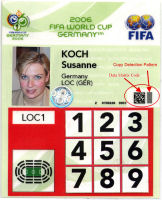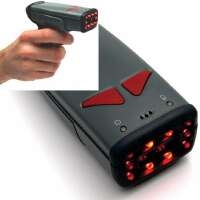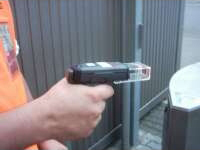FIFA Football World Cup 2006 - Products for Access Control
Background

Fig 1: FIFA World Cup access ID card with employee legitimation
Together with their system house partner MediaSec Technologies GmbH (a subsidiary of Thomson S.A.), the Pepperl+Fuchs subsidiary Omnitron AG provided a unique and future-proof security concept for the Football World Cup based on the 2D code hand-held scanner MAH200.
While "general" visitors to the World Cup received a ticket featuring RFID technology, a significantly more advanced access system was developed for accredited personnel. Approximately 150,000 in number, these persons were responsible for fulfilling different tasks in the 14 stadiums. From employees of cleaning firms to soft-drinks sellers, and of course the players and trainers of the teams, through to the high functionaries of the game. Each person was provided with an ID card which had to meet safety requirements similar to those already in place for German ID cards (photograph, perforation, hologram, lamination, etc.). In addition, an individual person-specific access legitimation was also necessary (see Fig. 1).
The challenges

Fig. 2: Data Matrix Code
No access to a central database was available at the verification points. This was due to the existing infrastructure of the stadiums and costs. Despite this, it had to be verified whether the person in question had the appropriate permission to access the stadium on this date, at the respective time, or for a particular zone. This meant this data had to be encrypted in the ID and automatically scannable. It was decided to use the Data Matrix Code (see Fig. 2).
This technology was already successfully tried and tested during the Confederation Cup and the Final Draw in 2005. However, FIFA and NOK increased the hurdles for the World Cup. A technology was required which was able to ensure that copies could also be detected by the scanner.
Solution

Fig. 3: ODT-HH-MAH200
The Copy Detection Pattern (CDP) technology which was invented by MediaSec was selected (see Fig. 1).
This is a process in which a pattern is incorporated as a primary print into the ID. Approximately 1 kByte of encrypted data is printed with a calculated degradation of 30%. This calculated printing degradation cannot be reproduced identically when copies are made. This allows the scanner to verify the integrity of the symbol.
Utilizing both Data Matrix and CDP technology is a unique and flexible way of verifying individual data and authenticity using a standard scanner. Furthermore, no additional costs arise when creating the documents because this technology makes use of existing printing processes.
The 300 scanners of type MAH200 that were used (see Fig. 3) were provided with special features. For example, part of the memory for batch operation was used to store a database. This database was updated with current data overnight. In this way, the scanners were able to verify the validity of the respective access data in a decentralized manner at the check points to decide whether the person concerned should be allowed access or rejected. In addition, the scanned ID data was logged and imported back to the central computer subsequently.

Fig. 4: MAH200 with optical head
The batteries in the MAH200 coped with daily 8 hour operation without problems. For the first time, an optical head was used to verify the CDP (see Fig. 4). This improved the quality of the image and simplified handling by the security personnel.
To verify the CDP, a second decoder was installed into the MAH200. In this way, the Data Matrix Code and the CDP was evaluated in the same device. The time it took to verify both characteristics was significantly under a second.
Outlook

Fig. 5: ID obligation on the edge of the field
This new method opens up exciting new possibilities in the field of authenticity verification and protection against forgery. Industries like cosmetics, pharmaceutical, tobacco products and other manufacturers of high-value products who face the problem of brand-name piracy, the black market or gray imports come into question as potential users. In the meantime, the concept has been ported to the MAH300. Stationary scanning systems are the next point on the agenda.
Wolfgang Weber
Omnitron AG
Pepperl+Fuchs Group





 +52 55 5636-0970
+52 55 5636-0970